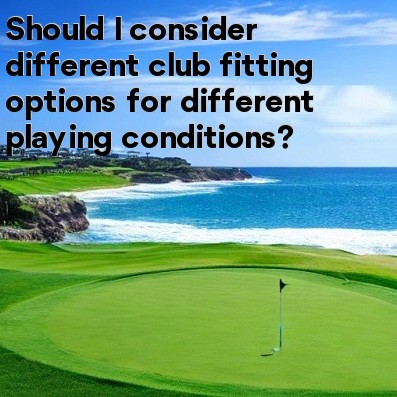
Should I consider different club fitting options for different playing conditions?
As a golfer, it is essential to have the right equipment that complements your swing and playing style. This includes having the correct club fitting to optimize your performance on the course. While club fitting is typically associated with getting the right club length, lie angle, shaft flex, and grip size, it is also important to consider different club fitting options for different playing conditions.
When it comes to club fitting for specific playing conditions, there are a few factors to consider:
- Course conditions: Different golf courses have various characteristics, such as firmness or softness of the fairways and greens. These conditions can greatly affect the way the ball reacts when it lands. For example, if you regularly play on courses with firm fairways, you might benefit from using clubs with lower lofts to optimize distance and roll. On the other hand, if you often play on soft and lush courses, higher lofted clubs can help you get better control and stopping power.
- Weather conditions: Weather conditions, including wind and temperature, can significantly impact your game. If you frequently play in windy conditions, it might be beneficial to have clubs with lower ball flights that can cut through the wind. Similarly, in hot and dry conditions, you might want to consider using clubs with higher lofts to generate more spin and control.
- Altitude: Altitude is another factor that can affect your club selection. At higher altitudes, the air is thinner, which means the ball will not travel as far. In this case, using clubs with lower lofts can help you achieve optimal distance and trajectory.
Having different club fitting options for different playing conditions can give you a significant advantage on the course. Here are a few ways you can adapt your club fitting to varying conditions:
- Carry distance versus roll: Depending on the conditions, you might need to prioritize carry distance or roll. If you play on firm courses, focusing on maximizing roll can help you achieve more distance. On the other hand, if the conditions favor a soft landing, prioritizing carry distance can help you hold the greens better.
- Choosing the right driver loft: Driver loft plays a crucial role in optimizing distance and accuracy. Lower lofts tend to produce a lower ball flight with more roll, while higher lofts generate a higher trajectory. By selecting the appropriate driver loft based on the course and weather conditions, you can improve your chances of hitting the fairways consistently.
- Adjusting iron lofts: Iron lofts can also be adjusted to adapt to different conditions. Some golfers choose to decrease the loft of their irons to account for firm fairways, while others may prefer to increase the loft for added control in soft or wet conditions.
In conclusion, considering different club fitting options for different playing conditions can be beneficial to your golf game. Understanding the characteristics of the golf course, weather conditions, and altitude can help you make informed decisions about your club selection. By optimizing your equipment for specific conditions, you can enhance your distance, accuracy, and overall performance on the course.





